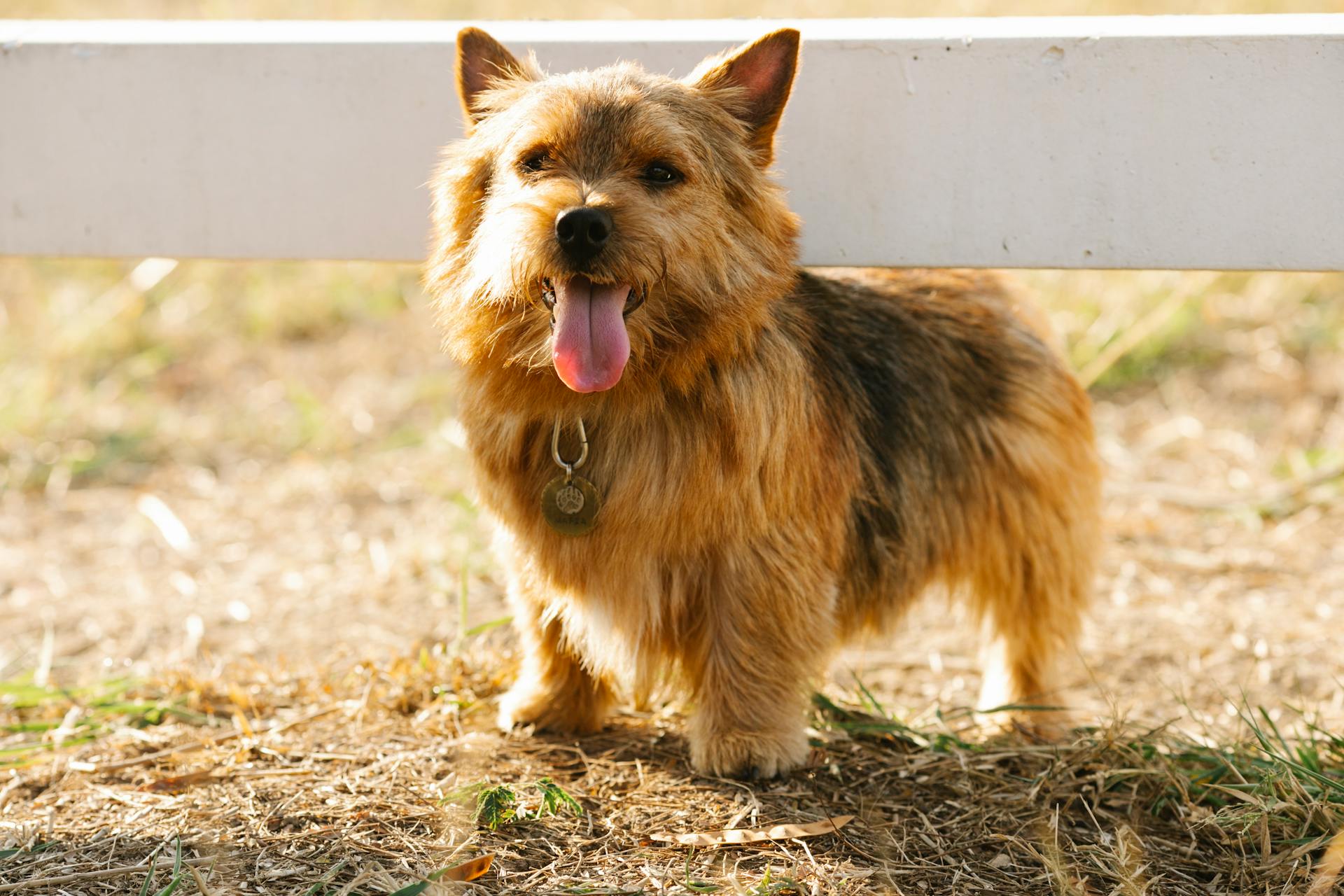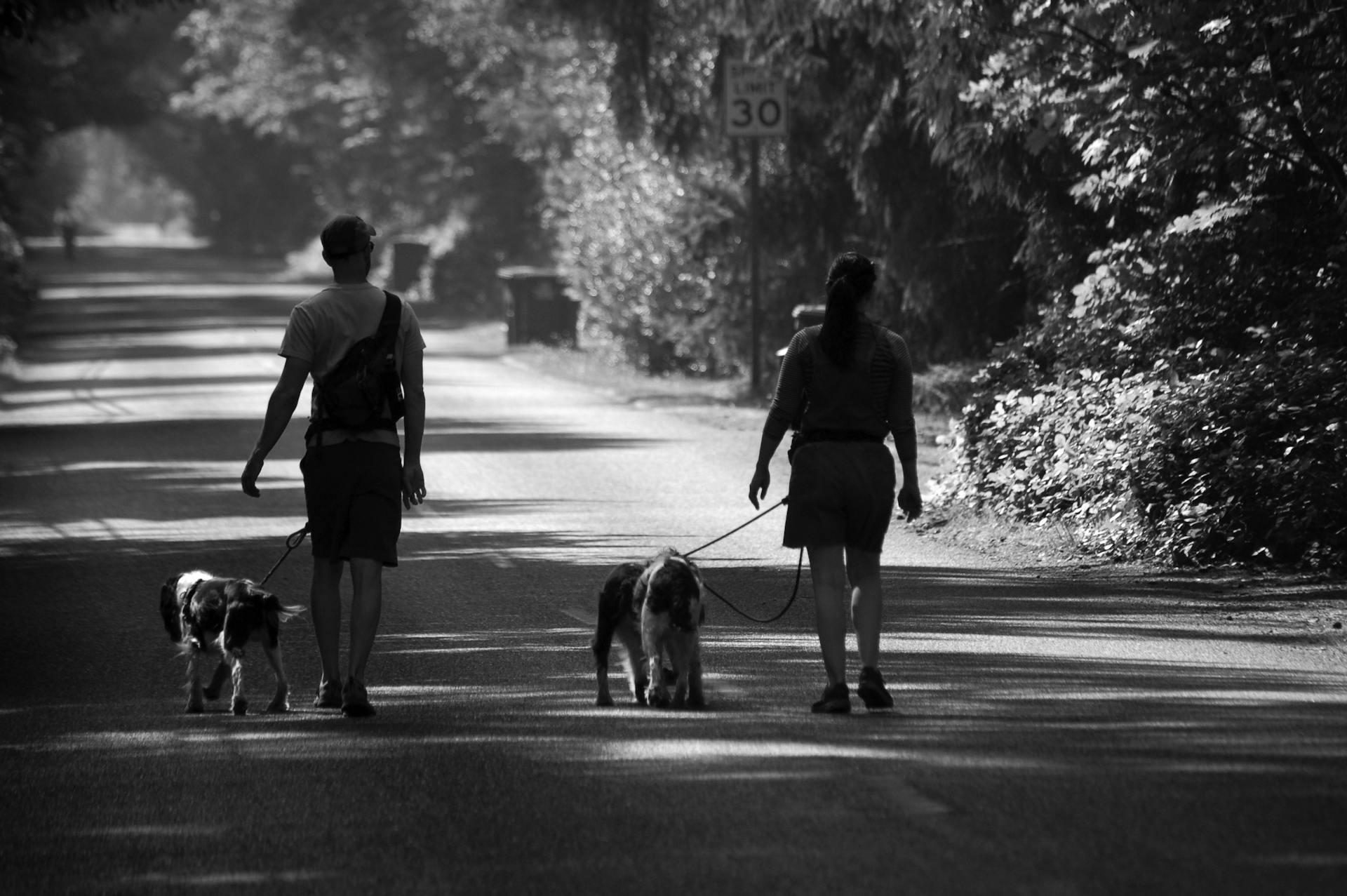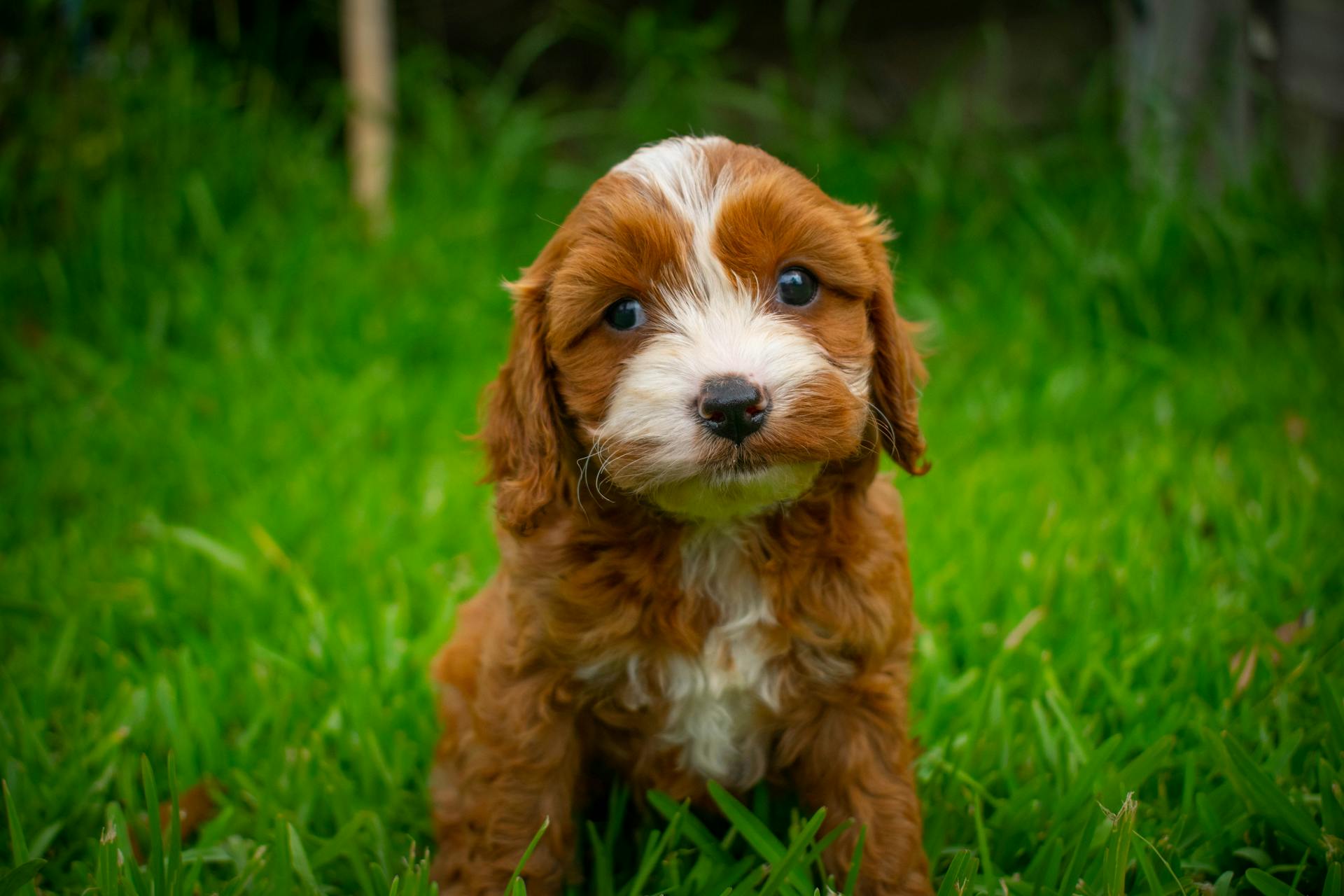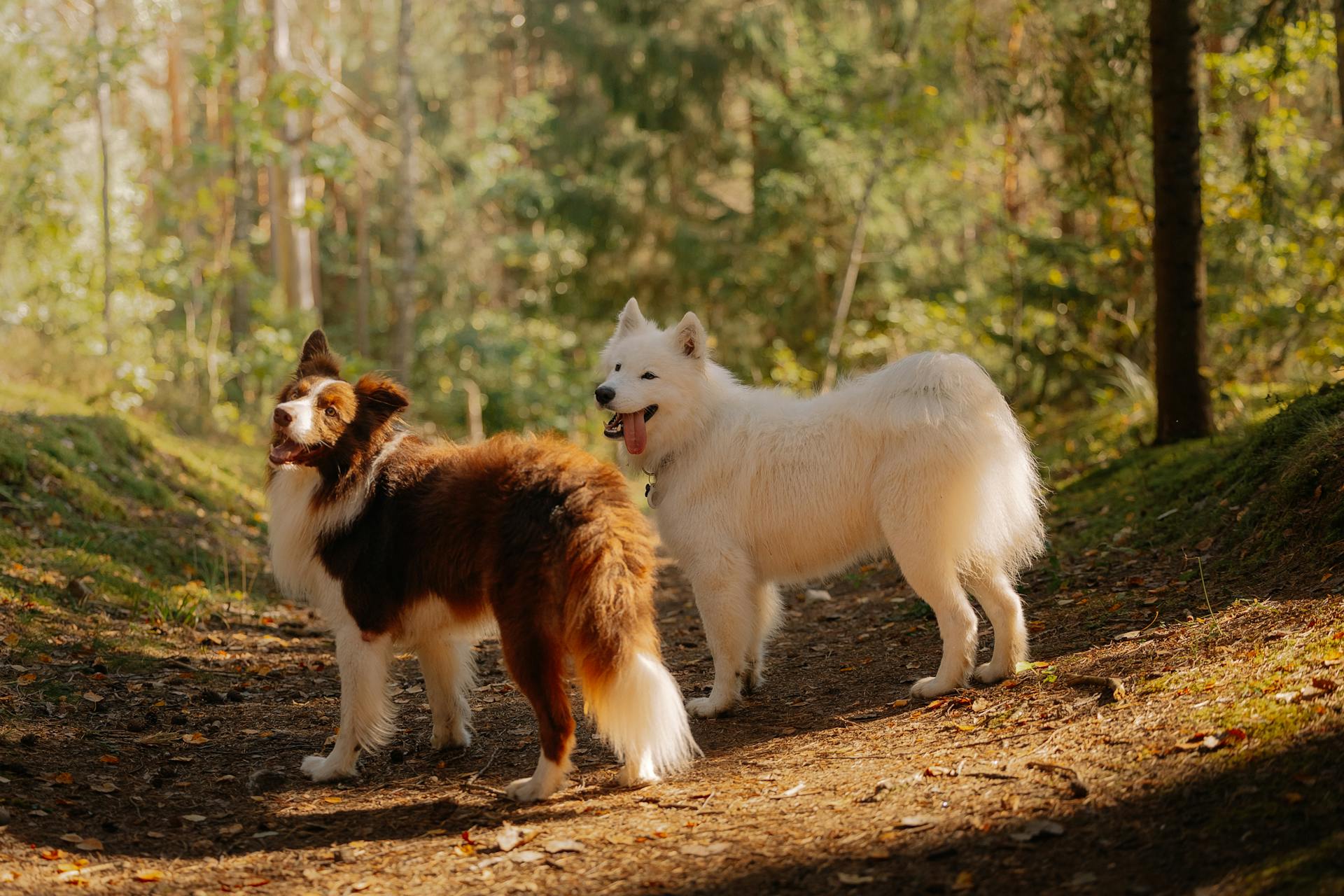
If you're looking for a furry companion that's also a skilled rodent catcher, you're in luck. The right breed can make a huge difference in your pest control efforts.
The Fox Terrier, for example, is a small but mighty breed that's known for its hunting prowess. With its sharp instincts and agility, it's no wonder this breed is often used for catching mice.
The Beagle, on the other hand, is a bit larger but just as effective at sniffing out rodents. Its keen sense of smell and energetic personality make it a popular choice for hunting small game.
If you're new to dog ownership, it's essential to remember that every breed has its unique needs and characteristics. Researching and understanding these factors will help you choose the perfect pup for your lifestyle.
See what others are reading: Best Breeds for Emotional Support Dogs
Dog Breeds for Rat Control
Dogs that catch rats are a thing, and they're actually really good at it. The best breeds for rat control are terriers, specifically the Patterdale Terrier, which is known for its strength and speed.
A Patterdale Terrier's jaw is so strong that it can destroy a Kong Jumbler Ball if given the chance. But don't worry, they're not aggressive and will only use their strength to catch rats. They're also super smart and can sniff out active rat burrows with ease.
Other good breeds for rat control include the Rat Terrier, which originated as a farm dog to keep rodents at bay, and the Jack Russell Terrier, which was bred to hunt small animals like rats and raccoons. Both breeds are energetic and need plenty of exercise to prevent destructive behavior.
Here are some key characteristics of these breeds:
These breeds are all great options for rat control, but remember to always provide them with plenty of exercise and mental stimulation to keep them happy and healthy.
Jack Russell
If you're looking for a dog that can help control rat populations, the Jack Russell Terrier is a great choice. They originated as fox hunters in England in the early 19th century.
Their small stature and speed, running up to 38 miles an hour, make them perfect for chasing small animals. This speed also helps them excel at hunting rats.
Jack Russell Terriers are energetic and have instinctual digging skills, so they can become destructive if not properly exercised. They need regular physical and mental stimulation to prevent this.
Their bravery and hunting skills make them useful on farms for chasing away and removing pests like rats, raccoons, and more.
You might like: Dog Food for Hunting Dogs
Manchester
Manchester Terriers originated in Manchester, England in the mid-1800s as rat exterminators. They were so good at it that they were often used in the sport of rat baiting.
The breed was created by crossing Black and Tan Terriers with Whippets to excel at both ratting and rabbit coursing. This made them ideal hunters.
The Manchester Terrier was a popular breed during the Victorian Era, with men favoring the standard version and women wanting a smaller version.
For more insights, see: King Shepherd Dog Breed Profile
Norwich
The Norwich Terrier is a fantastic breed when it comes to rat control. These tiny dogs originated in Britain in the 1800s to kill rodents on farms.
Their reputation as excellent ratters spread quickly, and by the late 19th century, Cambridge University students brought them in to help with rat problems on campus, earning them the nickname Cantab Terriers.
Norwich Terriers are native to East Anglia in England and were initially bred to hunt vermin. They're one of the smallest working terriers, weighing in at 11-12 pounds.
To give you an idea of their size, here are some key stats for the Norwich Terrier breed:
Their lifespan is impressive, ranging from 12-14 years, making them a long-term companion for rat control.
Rat
Rat control is a serious business, and some dog breeds are naturally better suited for the task than others. The Rat Terrier, for instance, is a small dog with incredible jumping abilities, able to leap five to six feet in the air despite standing only 16-19 inches tall.
The Rat Terrier's origins date back to the 19th century, when working-class British migrants brought ratter dogs to the U.S. These dogs were bred for speed to control pest populations, and over time, they were crossed with other breeds to create the modern Rat Terrier.
Some breeds, like the Manchester Terrier, were specifically bred for ratting, and their skills in this area are unmatched. Manchester Terriers originated in Manchester, England in the mid-1800s, and they were so good at ratting that they were often used in the sport of rat baiting.
Titan, a Patterdale Terrier, is a prime example of a dog that excels at sniffing out rat burrows. He's able to detect active burrows even when they've been abandoned, and his strong jaw and fast reflexes make him a formidable opponent for any rat.
Here are some key characteristics of the Rat Terrier breed:
The Rat Terrier's intelligence, loyalty, and high prey drive make them a great choice for farmers and hunters. However, they do require plenty of exercise to prevent destructive behavior.
Schipperke
The Schipperke is a small Belgium breed that dates back to the 1600s. They originated in the Dutch-speaking northern area of Belgium called Flanders.
Their ancestors were farm dogs that herded livestock, guarded property, and hunted game. This background makes them well-suited for rat control.
The Schipperke was bred to be smaller for peasants who couldn't afford bigger dogs. This compact size makes them ideal for small spaces or areas where larger dogs can't fit.
They are a light sleeper with a healthy bark, allowing them to excel as watchdogs. This means they'll alert you to any potential rat problems.
In their native Belgium, the Schipperke is considered a small shepherd. They're comfortable being around water, which is a bonus if you need to use them for rat control in areas with waterways.
The Schipperke was formally recognized in the 1880s and introduced to Great Britain and the U.S. in 1887.
Here's an interesting read: Dog Biscuits for Small Dogs
Training and Encouragement
Encourage interest by talking excitedly and rewarding your dog when they paw at the cage or become excited trying to reach a mouse. This will help build their enthusiasm for the game.
Let the mouse out in a contained space, such as a small room or with pet barriers, to allow your dog to chase it safely. A hamster ball can also be useful for keeping the mouse safe while your dog chases it.
Caitlin Crittenden recommends starting with the Follow the Scent Method and adding a live caged mouse once your dog is good at tracking the scent. Make sure to reward your dog for not eating the live mouse and to speak with your vet about necessary vaccines.
Readers also liked: Tortoises Live
Teddy Roosevelt
The Teddy Roosevelt Terrier is a remarkable breed that originated in the U.S. as small hunters.
They were developed from a variety of small and medium dogs of early American immigrants, likely crosses of Smooth Fox Terriers, Manchester Terriers, Beagles, Whippets, Italian Greyhounds, and the now extinct White English Terrier.
Their main purpose was to control rodent populations in the home and on the farm.
You might enjoy: Boston Terrier Bug

The breed was originally a variety of Rat Terrier with short-legs known as Type B.
The Teddy Roosevelt Terrier was named after President Teddy Roosevelt, who is believed to have owned a few of them.
In the 1990s, breeders divided the short-legged Rat Terriers into their own distinct breed.
The UKC officially recognized the breed in 1999.
For more insights, see: Extinct Old English Terrier
Encourage Interest
Encourage your dog's interest by talking excitedly when they paw at the cage or become excited trying to reach a mouse. This will help them associate the activity with positive reinforcement.
Reward your dog further with treats and praise when they show interest in the mouse. This will encourage them to continue engaging with the activity.
Let the mouse out in a contained space, using pet barriers with holes that the mouse cannot escape from, or in a small room like a bathroom. Alternatively, you can let a wild mouse go outside with your dog present.
Using a hamster ball for a pet mouse can be a useful tool, allowing the mouse to move around safely while your dog can chase it in the ball. This can be a fun and engaging way to encourage your dog's interest in the activity.
Expand your knowledge: What to Feed Dogs When You Run Out of Food
Training Q&A
Start with the Follow the Scent Method to teach your dog to track a scent. This method is recommended by Caitlin Crittenden, a seasoned dog trainer.
Make sure to use a healthy feeder mouse from the pet store, as it's safer than a wild one. This is crucial to avoid the risk of disease.
Don't let your dog eat the live mice during training, as it can lead to bad habits. Instead, kill them or fetch them after killing, then leave them alone in exchange for a reward.
Consult with your vet to determine the necessary vaccines for your dog to ensure they're protected when encountering rodents. This is essential for their health and safety.
Participating in barn hunting clubs can be a fun way to engage your dog in hunting activities, but make sure they're properly trained and vaccinated first.
Suggestion: Best Catch Dogs for Hog Hunting
Why Control Rats
Rats can transmit 35 diseases, including salmonellosis and the plague, making it essential to control their populations.
Dogs are well-suited for this task, with their highly developed sense of smell allowing them to detect rat burrows and active areas.
Some dogs, like Titan, have earned prestigious certifications for their rat detection abilities, making them invaluable assets for large facilities and buildings.
Dogs can detect rat activity even when there isn't a visible rat present, allowing for targeted and efficient treatments.
In fact, dogs have been used for centuries to control rat populations, with their use dating back to World War I.
Frequently Asked Questions
Will mice leave if they smell a dog?
Mice may leave if they detect a dog's scent, but their presence is no guarantee to completely eliminate a mouse problem. Using a professional dog to help catch mice is a more effective strategy.
What will a dog do if it sees a mouse?
If a dog senses a mouse, it may exhibit excited behavior such as running near walls, wagging its tail, and scratching or sniffing the area. This behavior is often a sign that your dog has detected a hidden mouse.
Sources
- https://thepawsitive.co/blogs/happytails/rat-dog-breeds-and-dogs-that-hunt-mice-rodents-vermin
- https://www.walthamservices.com/newsroom/titan-the-rodent-catching-dog/
- https://www.hepper.com/mice-and-rat-hunting-dog-breeds/
- https://www.greenmatters.com/p/guide-to-mouse-extermination-with-dogs
- https://wagwalking.com/training/catch-mice-1
Featured Images: pexels.com


